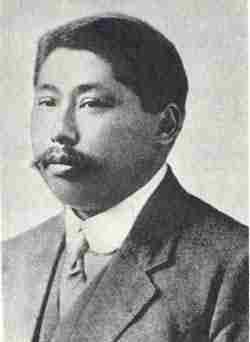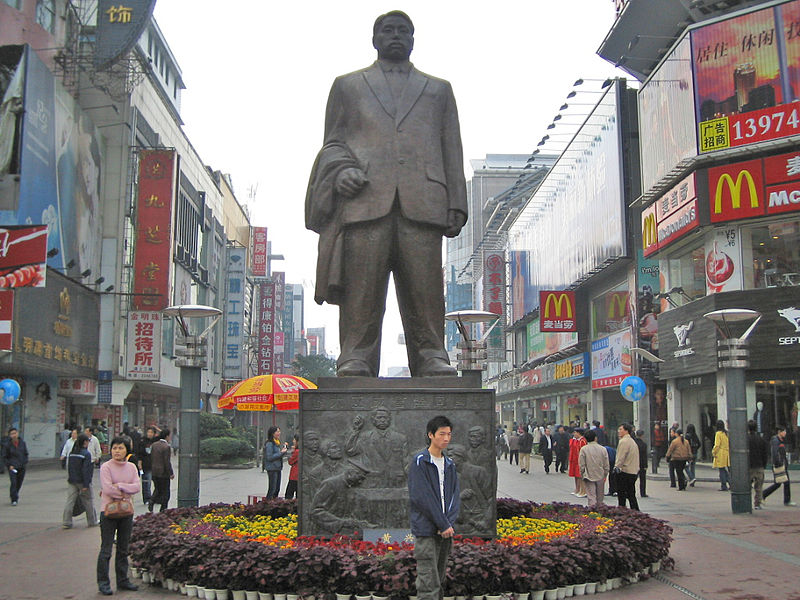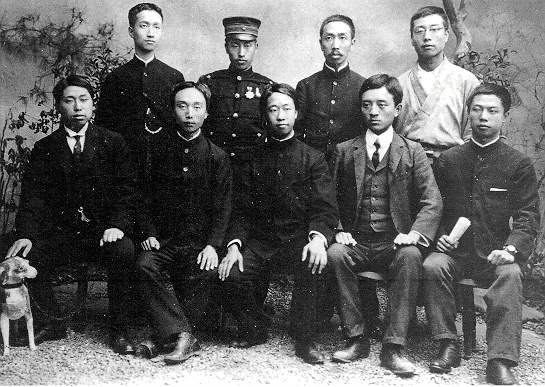<Back to Index>
- Commander - in - Chief of the Republic of China Huang Xing, 1874
PAGE SPONSOR


Huang Xing or Huang Hsing (traditional Chinese: 黃興; simplified Chinese: 黄兴; October 25, 1874 – October 31, 1916), was a Chinese revolutionary leader, militarist, and statesman, was the first army commander - in - chief of the Republic of China. As one of the founders of the Kuomintang (KMT) and the Republic of China, his position was next to Sun Yat-sen. Together they were known as Sun - Huang during the Xinhai Revolution. He was also known as the "Eight Fingered General" because of wounds sustained during war. His tomb is on Mount Yuelu, in Changsha, Hunan, China.
Huang was born in the village of Gaotang, now part of Changsha, Hunan.
Like many other Chinese men born before 1949, Huang was known by many
different names during his life. His birth name was "Huang Zhen", but
this was later changed to "Huang Xing". He was also known as "Huang
Keqiang" and "Qing Wu". In the period after 1911 he also used the names
"Li Youqing" and "Zhang Shouzheng".
Huang Xing began his studies at the prestigious South Changsha Academy in 1893, and received his Jinshi degree when he was only 22 years old. In 1898 Huang was selected to complete further study at Wuchang Lianghu College, from which Huang graduated in 1901. In 1902 Huang was selected by Zhang Zhidong to study abroad in Japan, and was enrolled in the Tokyo Hongwen University.
While
in Japan, Huang developed an appreciation for the study of military
affairs, and studied modern warfare under Japanese officers in his
leisure time. While living in Japan Huang practiced horsemanship and
shooting every morning. Huang's military training in Japan prepared him for his later role as a Chinese revolutionary.
In 1903, in order to protest against Russia's growing hegemony over Outer Mongolia and Manchuria, Huang organized a volunteer army of over two hundred fellow students in Japan. Later in 1903 Huang returned to China and organized a meeting with Chen Tianhua, Song Jiaoren, and more than 20 other people. The group founded the Huaxinghui, a secret revolutionary party dedicated to the overthrow of the Qing Dynasty. Huang Xing was voted president.
The
Huaxinghui cooperated with other revolutionary parties, and in 1905
scheduled an armed uprising in Changsha during the Empress's seventieth
birthday celebration. The Huaxinghui's plan was discovered, and its
members (including Huang) were forced to escape to Japan. In Japan Huang
met Sun Yat-sen and helped Sun found the Tongmenghui,
another revolutionary party dedicated to the overthrow of the Qing
Dynasty. Huang held the post of General Affairs Officer, and became the
Tongmenghui's second most important leader, after Sun. Following the
founding of the Tongmenghui, Huang devoted his time and energy to the
revolution.
In 1907 Huang secretly returned to China and traveled to Henei in order to participate in numerous revolts, including the Qinzhou Uprising, Fangcheng Uprising, and Zhen Nanguan Uprising. All of the revolts that Huang was active in failed. In the autumn of 1909, Huang was commissioned by Sun Yat-sen to establish the South Branch of the Tongmenghui, and to prepare the Party for a planned military uprising from Guangzhou. In the spring of 1909, Huang led another uprising, but this revolt also failed. In October 1909, Huang held an assembly with Sun Yat-sen in the British colony of Penang (now part of Malaysia). The assembly decided to concentrate human and financial resources in order to stage further uprisings in Guangzhou.
In
the spring of 1911, Huang established the Department of the Guangzhou
Uprising in Hong Kong,and became the Department's minister. On April 27,
Huang launched the Huanghuagang Uprising in
Guangzhou, and lead hundreds of people in an attempt to capture the
viceroy of Guangdong and Guangxi. Huang and his followers failed to
capture the viceroy, who climbed over a wall in order to escape them.
The Huanghuagang Uprising was the last unsuccessful revolt before the Wuchang Uprising ultimately succeeded in overthrowing the Qing Dynasty by the end of 1911.
On January 1, 1912,the Nanjing Interim Government was established, and Huang was selected to be one of its leaders. In August 1913 Huang became the director of the KMT. In March 1913, the provisional president of the newly formed Republic of China, Yuan Shikai, successfully assassinated the chairman of the KMT, Song Jiaoren, whose party had won China's first elections and who had shown indications of a desire to limit Yuan's powers within the new government.
In 1913 Yuan Shikai expelled KMT members from all government offices and moved the government to Beijing. Huang stayed in Nanjing, and attempted to reorganize the South Army in order to oppose Yuan. Because of shortage of money Huang's army later mutinied, and Huang had to abandon Nanjing and retreat to the foreign concession areas of Shanghai. Sun Yat-sen again fled to Japan in November 1913.
In July 1914, Sun organized armed forces to suppress Yuan, and the Second Revolution broke out. On July 14 Huang went to Nanjing from Shanghai, convinced the military governor of Jiangsu to declare independence from Yuan, and pushed to be the military commander in charge of suppressing Yuan's forces in Jiangsu. After Huang's rebellion in Jiangsu failed, Huang fled back to Japan.
Huang
went into exile in the United States in 1914, and Yuan Shikai
proclaimed himself emperor in 1915. While abroad, Huang raised funds in
order to raise a Yunnan National Protection Army to suppress Yuan. After
the death of Yuan, in June 1916, Huang returned to China. On October
1916, Huang died in Shanghai at the age of 42. On April 15, 1917, Huang
was given a state funeral, and was buried in Changsha on Yuelu Mountain.
- In Changsha, Nanzheng Street was renamed to Huang Xing Road in 1934. There are also roads named in honor of Huang Xing in Shanghai and Wuhan.
- The town where Huang Xing was born was renamed "Huang Xing Town" in his honor.
- Similar to the Zhongshan Parks, the Huang Xing Park in Shanghai is named after Huang Xing.
